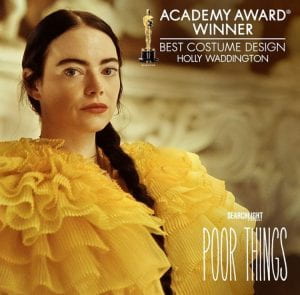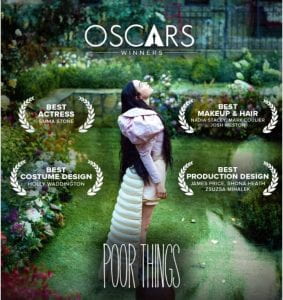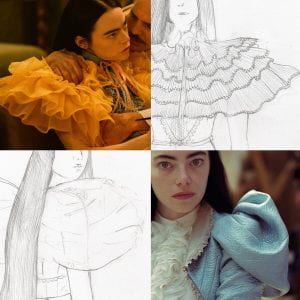
Figure 1. Emma Stone as Bella Baxter in ‘Poor Things’
As a society, we are fascinated by celebrity. Especially when it comes to big events like the Oscars, there tends to be endless speculation about what stars wear – both on the red carpet and within the celebrated films themselves. But do people always realise the design, styling, sourcing, and making work that goes on behind the scenes? There is so much attention on social media and TV devoted to costume – but how much is actually known about the teams of ‘crew’ behind the finished product? These fabulous outfits are always the culmination of many hours of rushing around, meetings, research and development, and communication between different designers. In addition, the makers, buyers, and assistants all need to be coordinated before the transportation/couriers can be organised. Good project management is essential and not easy in the creative rush of it all – but little of this groundwork is glamorous!

Figure 2. Poor Things: Winner of four Oscars
It is great to see so many brilliant films being recognised, and nominated for the artistry of so many departments. It is often the case that the immense amount of hard work which all these people have put into creating costumes goes unrewarded. One designer from many is chosen for an award to celebrate the vision and realisation this individual has brought to the final film, which in turn brings joy to audiences. However, this could be not achieved without a talented and dedicated team, great communication, a supportive and well set up working environment, plus money and time. Even with all these things, it is still a huge achievement that reflects the dedication of the entire team.
During its London pre-production phase, I was lucky enough to be a part of the Costume team on Poor Things, which won the Oscar for Best Costume this year. I started during the Covid lockdown in April 2021 as Costume Buyer, meeting with the Costume Designer Holly Waddington and her assistant Eleanor Bull, initially on Zoom. We looked at mood boards and sketches of the principal characters, and used them as inspiration for textures, materials, and colour palates. Having worked with Holly before, on the pilot for the TV show The Great, I knew how much she loved fabrics. I also knew that she was well informed about fabric types, and could be very specific, with a great way of describing shades of colour and texture.

Figure 3. Costume Designs by Holly Waddington and stills of Emma Stone as Bella Baxter
Holly comes from an Art History background, and has done time as a costumier at the big London costume house called Angels, so has an extensive knowledge of period costume. It was a joy to see her references and early designs and to work with her sourcing appropriate fabrics and developing these into ‘toiles’ (samples garments) for fittings with the cutter Jo Van Schuppen.
We worked out of an Art Deco, Grade 1 listed building, at 55 the Broadway (soon to be developed into a luxury spa hotel), above St James’s Park tube station in central London. Because it was during lockdown, there were no commuters, tourists, or even many shopkeepers around. There was just one TV production company using the block at the time, making a film called Pistol about the punk revolution, directed by Danny Boyle.
I had to make appointments with suppliers according to Covid regulations, which meant wearing a mask and having weekly Covid tests by an outside firm. Looking back, it all seems very surreal and special, which somehow befits the stylized outcome and themes of Poor Things. I was driving around London without traffic, past Buckingham Palace clear of visitors peering in through the gates – eerie and like never before!
The Production Design/Art department had already started prior to Costumes, so there were colour themes and textural references to work with from Shona Heath and James Price. They had worked closely with Yorgos Lanthimos, the Director, to create the world the characters would inhabit, spanning many cities, a ship, and curious interiors. All sets were designed, fabricated, and made from scratch, amazingly. Shona is from a fashion background and has designed and built sets for numerous high-end fashion brands, working with many famous photographers.
Holly came to me with brilliant descriptions of her colour palettes: e.g. “like the shades of a rotten apple” for the fabrics in Lisbon scenes. “Fleshy and visceral colours and textures, as if the fabric could be like offal, or liver” for Baxter, in London/Glasgow. References from “brain coral to intestines”, as ideas for spongy 3D fabric surfaces based on the Victorian Cloqué brocade silks, for Bella and other female characters. I sourced samples from my UK and Italian suppliers. After a couple of weeks of initial sourcing we had an idea of which garments we could proceed to buy fabrics for, and then make, as samples for fitting/approval by Yorgos and the key performers.
It was a brilliant opportunity to present all the wonderfully weird fabrics I could find! So often there is no place for them, but I slip a few under the noses of designers just in case they bring interest and inspire. Holly was grateful for all the heavy textures and lustrous swatches to help finalize her concept for each character. Her pencil designs were then reimagined in colour with the aid of Assistant Designer Eleanor Bull. In Photoshop, fabrics were scanned in and composited to create colour designs to share with Yorgos, the producers, and Shona’s Production Design team.
The rest of the decision-making and buying had to follow promptly, as a truck was coming to collect the materials and samples to go out to the Budapest studios. Sample books had to be duplicated so that our buyer/coordinator could order and send more over the rest of the pre-production period.

Figure 4: The UK (London) Costume team on Poor Things Left to right: Karishma Harjani – Costume co-ordinator, Jo Van Schuppen – Costume cutter, Sophie Bugeaud – Assistant costume designer, Miranda Pfunder – Costume buyer, Holly Waddington – Costume Designer, Eleanor Bull – Costume Design Assistant & Concept work, and Jessica Curties – Costume buyer at the cast and crew screening of Poor Things November 2023, London
The following week I said goodbye and good luck to Holly, her assistants, and the cutters, who would be joining and prepping their larger Hungarian team the following week. I certainly had the feeling that this had all the potential to be a brilliant and beautiful film. I mentioned to Holly that I thought she would get an Oscar for it, too!
Miranda Pfunder

Costumes in Poor Thing totally amazing – very fitting to the film and characters and what an eyeful of stunning outfits/fabrics/designs – I was blown away.
Lisa Smith